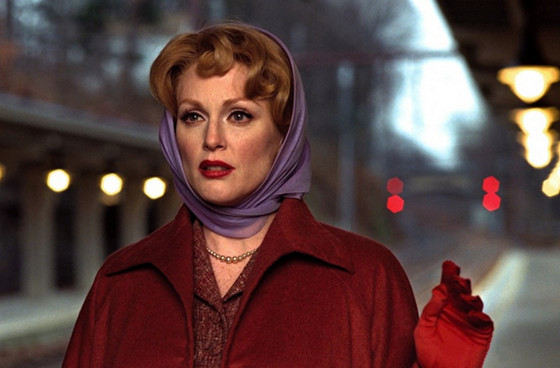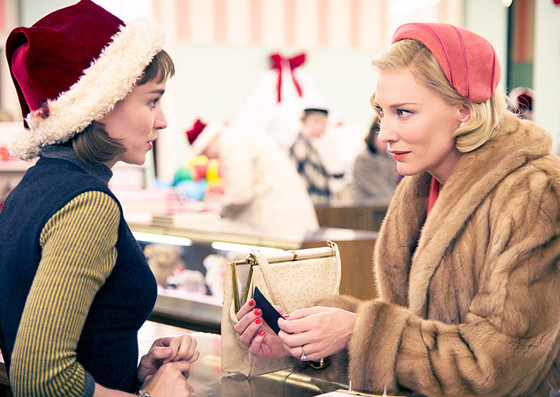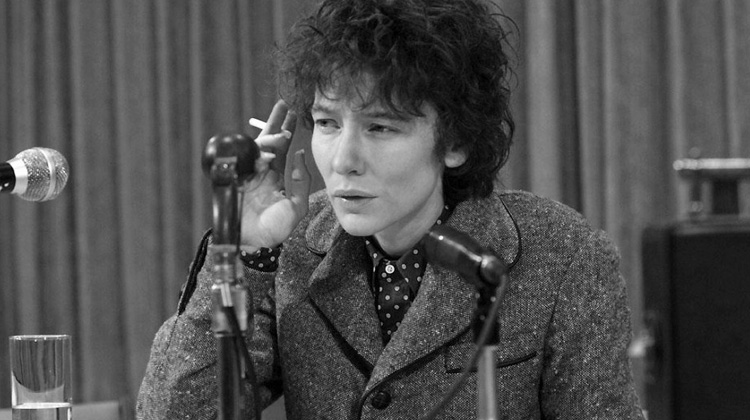4. Far From Heaven (2002)

Haynes’ first mainstream breakthrough came with this revisionist Douglas Sirk-style weepie from 2002, Far From Heaven. Once more his cinematic muse, Julianne Moore is wonderful as Cathy Whitaker, a 1957 Hartford, Connecticut housewife whose closeted gay husband Frank (Dennis Quaid), propels her into a taboo-shattering secret affair with Raymond Deagan (Dennis Haysbert), a black gardener. The surface tensions quietly roar in what results as a smashing simulacrum of not just Technicolor melodrama but also of the classic women’s picture.
Sexual repression, forbidden love, collective fears, bigotry, and the vivisection of social mores are given new and unexpected élan as cinematographer Edward Lachman’s skillful lensing and Haynes’ subtle palette of deep colors sharply spotlight Moore’s delicate portrayal of demure, restless middle-class American femineity. Cruelly honest and quite brilliant, Far From Heaven is one of the most immaculately accomplished melodramas around.
3. Carol (2015)

Set in a post-war early-50s New York, Carol is an elegant and restrained lesbian love story for the ages. Adapted from Patricia Highsmith’s (Strangers on a Train) 1952 novel, The Price of Salt, and functioning as a sort of companion piece to director Todd Haynes 2002 film, Far From Heaven, it stars Cate Blanchett is the titular Carol Aird, a wealthy yet long suffering housewife, and she exhibits all the glamor, grace, and gravitation of a scorching screen-siren of the calibre of Marlene Dietrich or Greta Garbo. And then there’s Therese Belivet (Rooney Mara), timid and tenderhearted, a tad thin skinned, but the two of them, once smitten and entwined, are societal outcasts, vulnerable to assail and misunderstanding.
Haynes is stylish as ever, here tenderly tapping into the Old Hollywood éclat, making a postmodern melodrama that is more than pastiche and rich in period detail and decorum. An elegant, and poignant film, Carol ranks with Haynes finest, an intoxicating, restrained, and vibrant story of love and lament. It’s an absolute scorcher.
2. Safe (1995)

An existential art house horror movie, Safe coolly details the catastrophe that awaits a Los Angeles woman, Carol White (Julianne Moore, brilliant), who’s allergic to her own environment. A masterpiece of detached uncertainty and creeping dread, Safe is also, in my estimation, one of the best American films of the nineties.
Carol is a So Cal housewife in the year 1987, where she leads a humdrum life in a sober suburban façade that slowly starts to languish around her. She has lifeless sex with her addled husband (Xander Berkeley), she shops, and gossips, and has hair appointments, and her comfortable existence crashes down bit by bit.
The horror of Haynes’ film rests amidst the anxiety in Carol’s day-to-day life, her disconnect with her family, and her inability to function. Haynes shows an at times Kubrickian sense of spacial dynamics, occasionally throwing back to 70s paranoia thrillers (think the Conversation, Marathon Man, and the Parallax View), and evidence of an Antonioni-like woman in distress vibe (Il Deserto Rosso specifically), yet still retaining his own inventive modes and manipulations.
As an exercise in visual style, Haynes proves his mastery with Safe, a film that demands a clear-sighted measure from the viewer. It hints at slow cinema with its persistent use of master shots, and it makes for a prime example of chic postmodernist cool. He allows his carefully composed shots to linger, to escalate, to alienate, resulting in a captivating and controlled patchwork that wavers to the diligent viewer’s whim.
Ultimately with Safe, Haynes presents a somnambulant nightmare of consumerist decay, of a woman’s life leeched of vitality, secure only in the knowledge that something is terribly, terribly wrong.
1. I’m Not There (2007)

One might be tempted to apply the oft-used term “biopic” to describe Haynes’ I’m Not There, a film “inspired by the music and the many lives of Bob Dylan”, but it’s more accurately a ravishing extended in Dylanology.
Featuring no less than six actors (among them Cate Blanchett, Marcus Carl Franklin, Richard Gere, and Heath Ledger) as aspects of Dylan’s multifaceted self, the resulting film is an unconventional, inventive, high-flown, and absolutely beaming musical rollick that spans the five intoxicating decades of Dylan’s entertainment career.
Displaying a gobsmacking supply of contrasting visual styles, unique and varied editing techniques, and lionhearted performances from a virtuoso cast (Blanchett’s brilliant performance deserved all the acclaim and awards it mustered but also outstanding is Charlotte Gainsbourg’s heartbreaking turn as Claire Clark, and David Cross as Allen Ginsberg may just be the casting coup of the decade) make certain that I’m Not There is an absolutely singular cinematic experience.
Not once in the film’s dense and dulcet 135 minutes are the words “Bob Dylan” even uttered, and none of the cast who portray him go by such nomenclature, and yet the transience and inscrutableness of identity is given truly golden confidence and poetry. To call I’m Not There a tour de force is matter-of-fact, that it’s ambitious, challenging, surreal, and occasionally beautifully byzantine is likewise a foregone conclusion.
Haynes’ films, and I’m Not There in particular, often contend the blur of passion and pretension in the protagonist. This obsessive and persistent Dylan film displays all of Haynes’ preoccupations in one form or another, making it the ultimate and most authentic compendium of his tremendous work. It provokes laughter, tears, elation, and endless revelation. Essential viewing.
Author Bio: Shane Scott-Travis is a film critic, screenwriter, comic book author/illustrator and cineaste. Currently residing in Vancouver, Canada, Shane can often be found at the cinema, the dog park, or off in a corner someplace, paraphrasing Groucho Marx. Follow Shane on Twitter @ShaneScottravis.